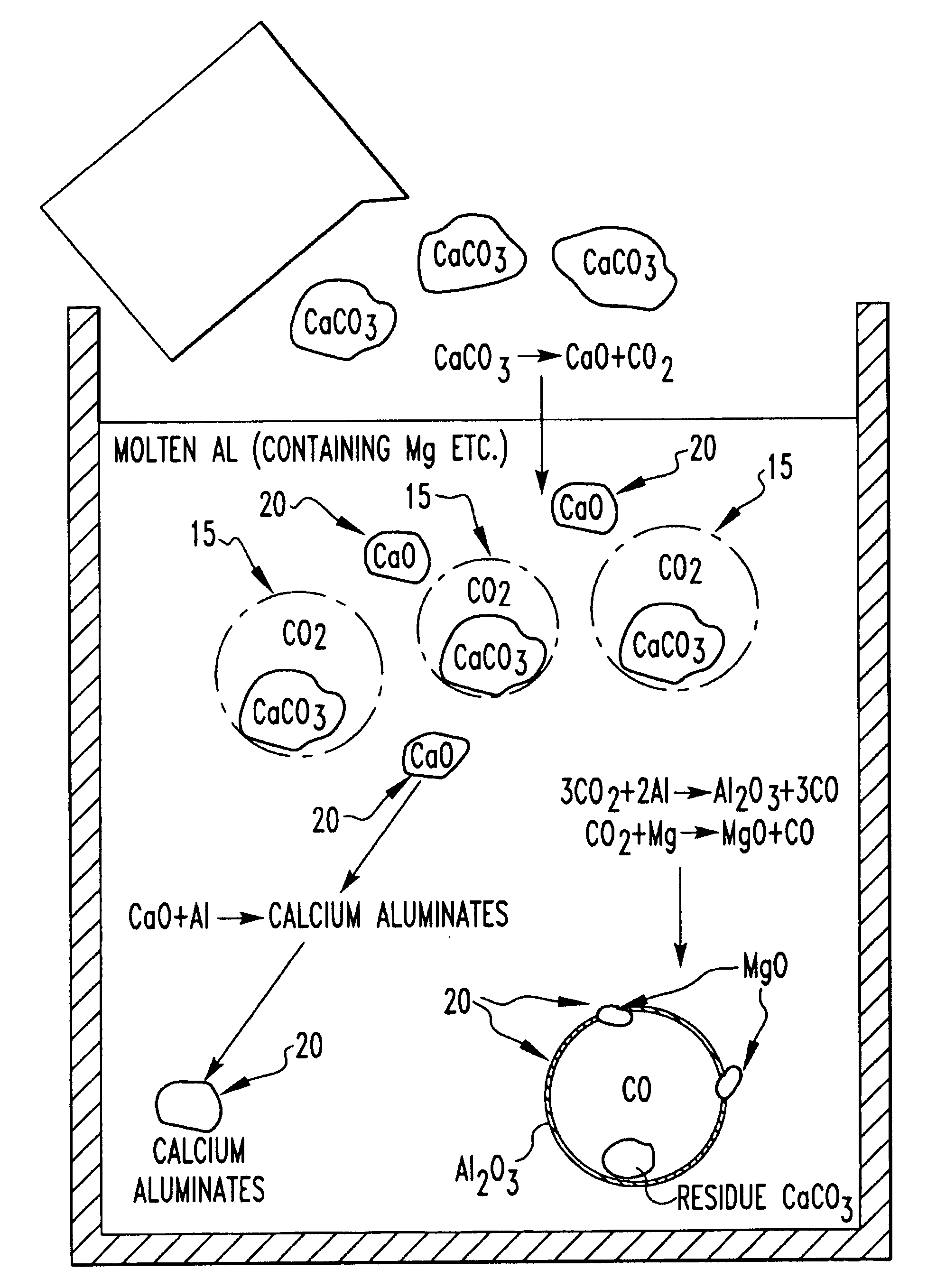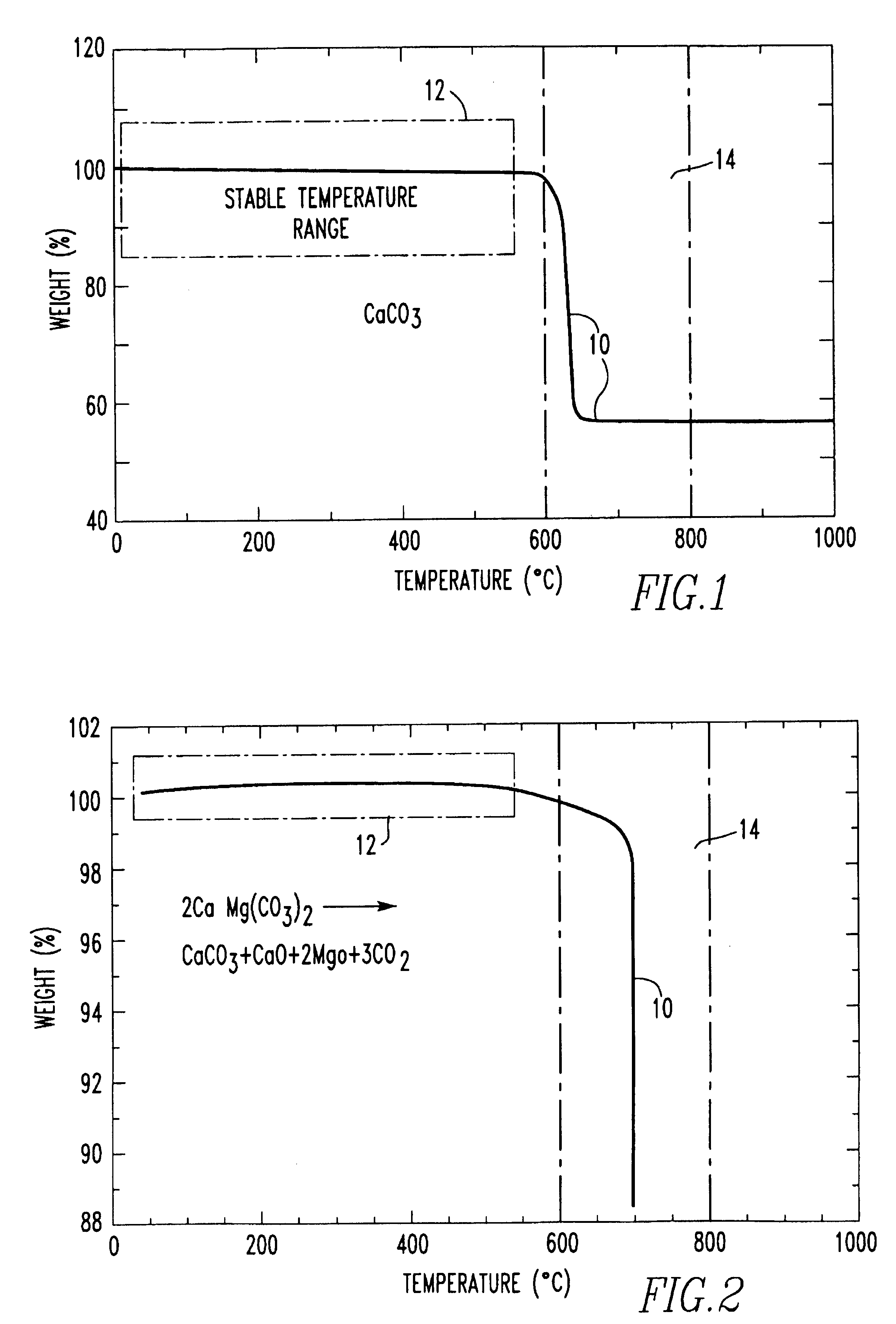Method for producing foamed aluminum products by use of selected carbonate decomposition products
a carbonate decomposition and aluminum technology, applied in the field of foamed aluminum products, can solve the problems of large cell size, high cost of materials, limited application of foamed metal products, etc., and achieve the effects of improving properties, low density, and high rigidity
- Summary
- Abstract
- Description
- Claims
- Application Information
AI Technical Summary
Benefits of technology
Problems solved by technology
Method used
Image
Examples
example 1
Effect of Reactive Gas Producing Particles on Stability in Aluminum Alloy Foams
[0091] A series of aluminum alloy melts were prepared to determine the effect of calcium carbonate on the stability of the aluminum foam and the propensity for gravitational drainage in the foamed structure. Specimens comprising 100 gm of an aluminum-2 wt. % magnesium alloy were melted and stirred vigorously for different times while adding various weight fractions of calcium carbonate powders. Following agitation, a separate chemical foaming agent was added and dispersed for 30 seconds. In these tests that chemical foaming agent was calcium carbonate. The various specimens were then foamed and the rise of the aluminum foam monitored.
[0092] Following foaming, the specimens were rapidly cooled and foam specimens sectioned, weighed, photographed, and the density calculated. The results of these tests are shown in FIG. 9. The results clearly show the role of calcium carbonate in creating a stabilized alumi...
example 2
Effect of CaCO3 Particle Size Distribution on Foam Structure
[0096] A series of aluminum alloy melts were prepared to determine the effect of size and weight fraction of calcium carbonate (reactive gas producing particles) on the stability of the aluminum foam and the propensity for gravitational drainage in the foamed structure. Specimens comprising 100 gm of an aluminum-2 wt. % magnesium alloy were melted and stirred vigorously for 6 minutes after adding various weight fractions of calcium carbonate powders. The results of this experimentation are shown in FIG. 10, in which particles labeled “coarse” correspond to volume average diameters of 150 microns, while those labeled as “fine” correspond to volume average diameters of 40 microns. The finer carbonates clearly show greater efficacy in stabilizing the aluminum melt. At a 2 wt. % carbonate addition, the “coarse” addition resulted in a average foam density of 25%, while the “fine” particles resulted in a density of 17%. This fin...
example 3
Effect of Magnesium Addition on Stabilization of Aluminum Foams
[0097] A series of aluminum alloy melts were prepared to determine the effect of magnesium level on the stability of the aluminum foam and the propensity for gravitational drainage in the foamed structure. Specimens comprising 100 gm of an aluminum and various levels of magnesium were melted and stirred vigorously after adding 20 wt. % calcium carbonate powders. The results are shown in FIG. 11. A marked effect is seen on the addition of 2 wt. % Mg (for this particular carbonate size and weight fraction), with relative density of the foam product dropping from near full density to 25 wt. %. Higher additions of Mg have limited effect on foam density itself.
PUM
| Property | Measurement | Unit |
|---|---|---|
| decomposition temperature | aaaaa | aaaaa |
| volume averaged size | aaaaa | aaaaa |
| weight percent | aaaaa | aaaaa |
Abstract
Description
Claims
Application Information
 Login to View More
Login to View More - R&D
- Intellectual Property
- Life Sciences
- Materials
- Tech Scout
- Unparalleled Data Quality
- Higher Quality Content
- 60% Fewer Hallucinations
Browse by: Latest US Patents, China's latest patents, Technical Efficacy Thesaurus, Application Domain, Technology Topic, Popular Technical Reports.
© 2025 PatSnap. All rights reserved.Legal|Privacy policy|Modern Slavery Act Transparency Statement|Sitemap|About US| Contact US: help@patsnap.com



